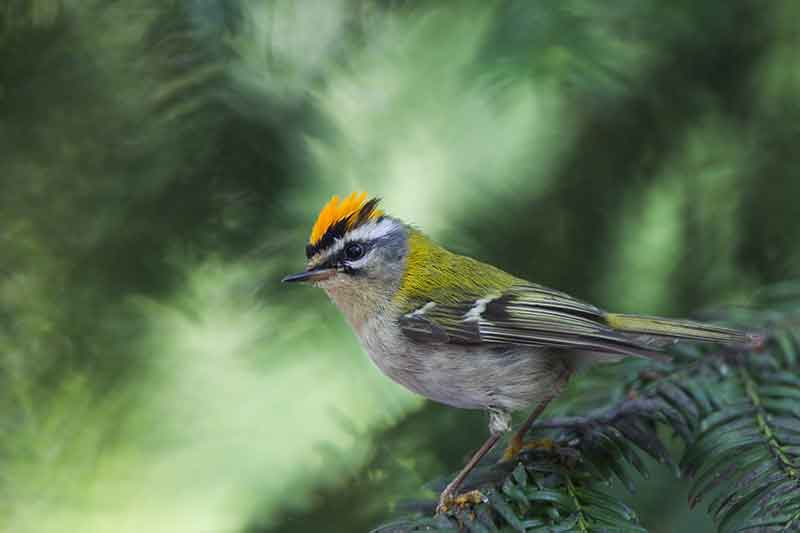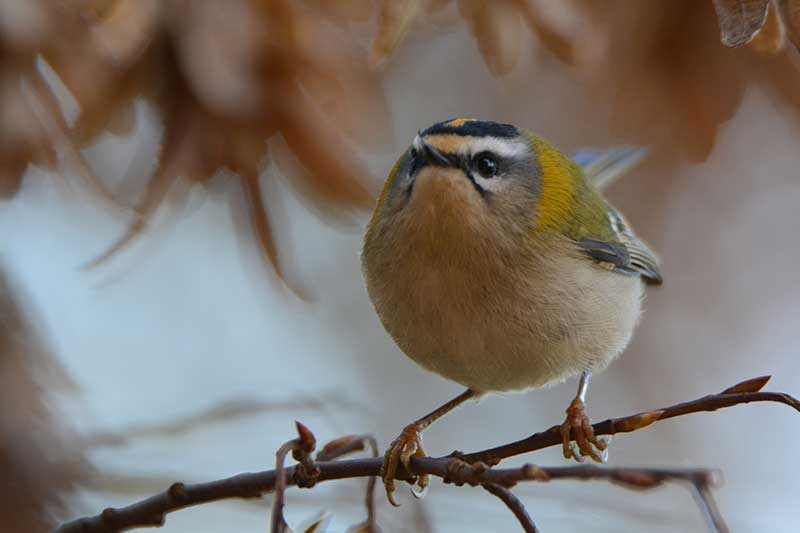Main Menu

Breeding birds: 2,000 territories
Winter visitors: 250 birds
Family: Kinglets
The adult male firecrest has olive-green upperparts with a bronze patch on the shoulder. Its flight feathers are edged with yellow-green, and it has two white wing bars, along with a black patch at the base of the secondaries. The underparts are creamy white, with a pale grey belly.
The head is grey with a black crown with a bright orange stripe running through the centre, ending at the back of the head. The forehead is yellowish, and there is a broad white stripe above the eye, with a finer white crescent below. The lores are black, with a black line extending to the ear coverts, and a fine black malar stripe is present. The bill is black, the eyes are dark brown or black, and the legs and feet are brown.
The female is similar to the male, but the crown stripe is a duller yellow and may sometimes be absent entirely.
Juveniles have duller plumage overall and lack the distinctive head pattern.
Try our interactive bird identifier
Firecrests breed between April and August, producing two broods per season. They are monogamous during the breeding season but do not mate for life. During courtship, the male sings to attract a mate, often raising his crest. He also defends his territory by pointing his bill forward at a rival, displaying his crest and head pattern.
Firecrests build their nests in mature conifer trees or deciduous trees covered in creepers such as ivy. The female constructs the nest alone, creating a cup-shaped structure with a side entrance. The nest consists of three layers: an outer layer made of moss, lichens, twigs, and spider webs; a middle layer of softer mosses and lichens; and an inner layer lined with soft materials such as down, hair, and feathers.
The female lays 6–13 pink eggs with red markings and incubates them for two weeks while the male provides food. After hatching, the young fledge at around three weeks old but continue to be fed by their parents for another two weeks. Firecrests reach sexual maturity at one year old.
Firecrests are insectivorous, feeding primarily on aphids, spiders, moth eggs, and other small insects. They forage by gleaning prey from the upper surfaces of leaves and branches and occasionally catch larger spiders.
In winter, firecrests join mixed-species feeding flocks with small birds such as tits and warblers. They may also venture into gardens, where they feed on suet and other high-energy foods.

Firecrests are mainly found in the southeast and southwest of England, as well as some parts of Wales. They can be difficult to spot as they are constantly moving, but they are often found in woodlands, thickets, and dense evergreen vegetation such as holly and ivy.
Firecrests often nest near goshawks, which help protect them by preying on potential threats such as sparrowhawks, jays, great spotted woodpeckers, and squirrels that might steal their eggs or chicks.
One Response
Just had one at window in Northern Ireland